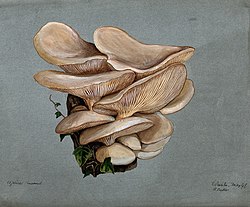Biology:Pleurotus euosmus
| Pleurotus euosmus | |
|---|---|

| |
| Scientific classification | |
| Domain: | Eukaryota |
| Kingdom: | Fungi |
| Division: | Basidiomycota |
| Class: | Agaricomycetes |
| Order: | Agaricales |
| Family: | Pleurotaceae |
| Genus: | Pleurotus |
| Species: | P. euosmus
|
| Binomial name | |
| Pleurotus euosmus (Berk.) Sacc., 1887
| |
| Synonyms | |
|
Pleurotus ostreatus euosmus (Berk.) Massee, 1893 | |
| Pleurotus euosmus | |
|---|---|
| Mycological characteristics | |
| gills on hymenium | |
| cap is convex or depressed | |
| hymenium is decurrent | |
| stipe is bare | |
| spore print is pink | |
| ecology is saprotrophic or parasitic | |
| edibility: choice | |
Pleurotus euosmus, also known as tarragon oyster mushroom, is a species of edible fungus in the genus Pleurotus, It is quite similar to the better-known Pleurotus ostreatus, but it is distinguished by its strong smell reminiscent of tarragon and substantially larger spores.
Description
General
- The cap grows from 5 to about 15 cm, with beige-tan to dingy-brown surface. It is first convex, becoming plane and then depressed with age.
- The stem is short, sometimes absent, may be forked and can vary from excentric to fairly central. Each stem may be up to about 12 cm long and up to 2 cm thick.
- The dingy gills are decurrent down the stem and broad.
- The spore print is pale pinkish-lilac.[1]
Microscopic characteristics
- The spores in the form of a rather elongated ellipsoid are around 12-14 µm by 4-5 µm.[1]
Distribution, habitat & ecology
This mushroom is saprotrophic and can also be a weak parasite. It occurs in stumps and fallen trunks, preferring elms. It is fairly rare, limited to the British Isles, reported only in England and Scotland.[1]
Similar species
Pleurotus euosmus is quite similar to the well-known food mushroom Pleurotus ostreatus, to the point of Watling & Gregory having considered P. euosmus a variety of P. ostreatus. However, later phylogenetic research has shown it is more closely related to Pleurotus citrinopileatus and Pleurotus cornucopiae, belonging to their intersterility group in P. djamor-cornucopiae clade.[2]
Human impact
This mushroom is edible and it can be cultivated in a manner similar to P. ostreatus.[1] It is cultivated by individual hobbyists, but not cultivated on a wide/commercial scale.
References
- ↑ 1.0 1.1 1.2 1.3 Stamets, Paul (1993). "Chapter 21: Growth Parameters for Gourmet and Medicinal Mushroom Species". Growing gourmet and medicinal mushrooms = [Shokuyo oyobi yakuyo kinoko no sabai] (1st ed.). Berkeley, California, USA: Ten Speed Press. pp. 309–312. ISBN 0-89815-608-4.
- ↑ Vilgalys, R.; Moncalvo, J.M.; Liou, S.R.; Volovsek, M. (1996). "Recent advances in molecular systematics of the genus Pleurotus". in Royse, D.J.. Mushroom biology and mushroom products: proceedings of the 2nd International Conference, June 9–12, 1996. University Park, PA (USA): Pennsylvania State University: World Society for Mushroom Biology and Mushroom Products. pp. 91–101. http://wsmbmp.org/proceedings/2nd%20international%20conference/MBMP%20Proceedings%20of%20the%202nd%20International%20Conference%20(White%20book)/8%20Recent%20Advances%20in%20Molecular%20Systematics%20of%20the%20Genus%20Pleurotus.pdf. Retrieved 2011-03-10.
Wikidata ☰ Q10634526 entry
 |

